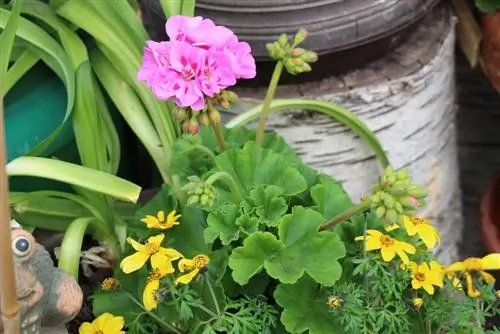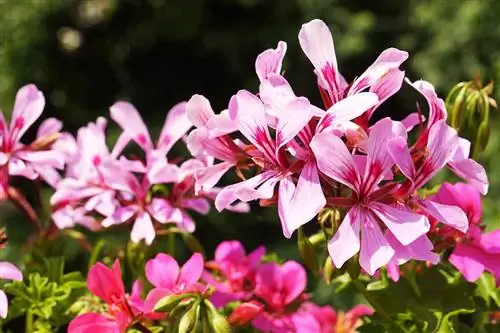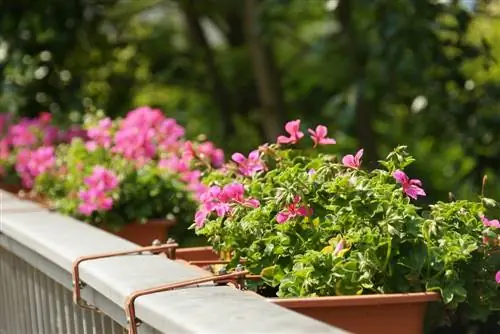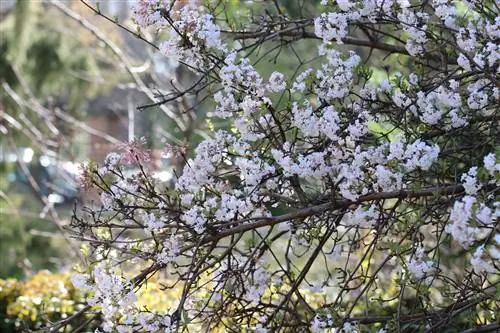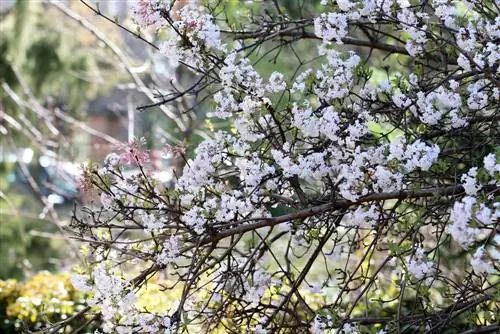- Author admin [email protected].
- Public 2023-12-17 03:39.
- Last modified 2025-01-24 12:45.
Flowers galore. Refreshing scents of lemon, mint or roses. Scented pelargoniums, also known as scented geraniums, give us all of this. They originally come from distant Africa. They have long since taken Central Europe by storm. No wonder, because they usher in spring and still lounge in the autumn sun. With proper care, they cannot be surpassed in terms of endurance.
Location
Anyone who plants scented geraniums already has an image in their mind's eye of a plant that has grown strongly and is covered in flowers. In order for this wish to be fulfilled, the location must not be experimented with.
- particularly lots of long sunshine
- it can be airy and bright
- Rain and wind are not good for her
- Covered terraces and balconies are ideal
- also a place on the wall under the eaves
- Scented pelargoniums are not suitable for the garden bed
- they are not protected against frost
- In summer they belong outside, in winter they belong inside
- Planting in containers makes moving in the fall easier
Note:
An unsuitable location does not kill the fragrant pelargonium. However, it only enables her to live an unworthy life: the growth is stunted, the flowers are sparse and the pests have an easy time of it.
Substrate
Geraniums and pelargoniums are related in the broadest sense. Both come from the cranesbill genus. Due to the similarity, scented pelargoniums are also casually referred to as scented geraniums. Special geranium soil is available commercially for geraniums. This can also be used safely for scented pelargoniums.
- Geranium soil
- or normal potting soil for flowering plants
- Add some sand to loosen it up
- Drainage layer made of expanded clay, pottery shards or stones
Tip:
Cover the drainage layer with fleece. This prevents potting soil from clogging the drain.
Plants
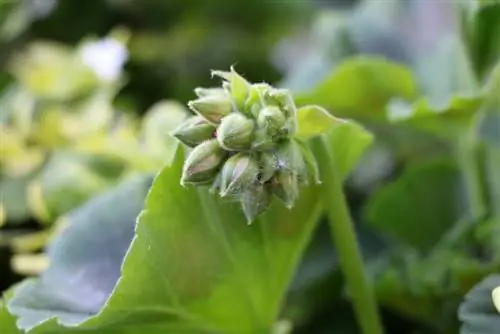
The decorative pelargoniums are often planted as a decorative border on balconies and terraces. They express themselves particularly well in society. You usually use several scented geraniums per balcony box. A combination with other plants is also possible.
- Choose a large flower box or a large pot as a planter. Both should have plenty of drainage holes.
- First place a few pieces of pottery, expanded clay or stones as a drainage layer. Some modern balcony boxes already have a corresponding drainage device.
- Fill the planter halfway with substrate.
- Put the scented pelargoniums in it.
- There should be a distance of around 20-30 cm between individual plants.
- Fill the gap with substrate. Press it lightly.
- Water planted pelargoniums well.
Tip:
Pelargoniums do not necessarily have to be replanted every year. Although they are not hardy, they can overwinter in suitable winter quarters.
Repotting
Whenever the roots grow out of the flower pot, the pelargonium needs a larger home. In addition, the old substrate should be replaced with new substrate every 2-3 years.
- when the roots grow out of the pot
- then choose a larger pot
- Spring is the right time
- change the substrate every 2-3 years
Tip:
Dark overwintered pelargoniums are repotted every spring anyway. This is the ideal opportunity to give her a larger bucket if needed.
Pouring
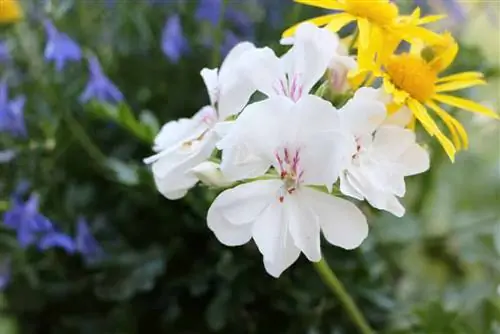
Pelargoniums cope better with occasional drought than if they swim in water. If it's too dry for them and they let their leaves hang, you can quickly revive them with a big sip of water.
- water moderately
- don’t water too much even on hot days
- when the top layer of soil has dried out
- there's nothing wrong with tap water
- However, rainwater is optimal
Fertilize
With the beginning of the growing season in spring, scented pelargoniums need the first fertilizer. The nutrients are urgently needed for the formation of countless flowers. The “scent production” also depends on it.
- fertilize from April to September
- Use commercial liquid fertilizer
- Geranium fertilizer is also suitable for pelargoniums
- undiluted fertilizer can burn the roots
- never administer on dry soil
- Always add fertilizer to the irrigation water
- usually fertilize every 2-3 weeks
Note:
Did you know that the scent of pelargoniums does not come from their flowers? It is the leaves that carry the pleasant smell. You can usually bring out its full intensity by rubbing the leaves.
Cutting
With scented geraniums, it is this year's new shoots that produce the hoped-for flowers. In addition to promptly removing dead shoots, annual pruning before new growth is recommended.
- if wintering in the dark, cut before winter
- Waiting for spring when wintering in the light
- Remove shoot tips, buds, flowers and almost all leaves
- shorten bare stems significantly
- only 10-20 cm may remain
- cut continuously during the flowering period
- remove all dead shoots
- this is how new growth is stimulated
Note:
It's not just flower formation that benefits from scissors. The growth also becomes more branched and forms a dense green.
Propagation by cuttings
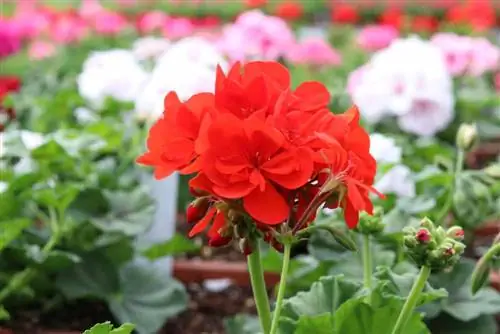
The easiest way to propagate pelargoniums is through cuttings.
- from spring to summer
- Choose shoots with leaves but without flowers
- clip off lower leaves
- Put shoots in the water
- warm and bright location, without direct sun
- waiting for the first roots
- planting rooted cuttings
- alternatively: plant freshly cut cuttings immediately
- then keep the soil moist throughout
- Cover soil with foil if necessary
Tip:
New plants grown early in spring develop some flowers in the same year. The following year they grow into a strong plant.
Propagation by sowing
Scented pelargonium seeds are available in specialist shops. This is a cost-effective alternative to obtain numerous new plants.
- sow early in January
- in pots with potting soil
- ideal germination temperature is around 20 degrees Celsius
- place bright, warm and without direct sun
- Prick out young seedlings
- slowly get used to the sun in spring
- after the Ice Saints the young plants are allowed outside
Note:
Pelargoniums germinate in light. Your seeds must only be thinly covered with soil, otherwise they will not germinate.
Wintering
When the last inflorescences have faded and the leaves fall or turn brown, it is time to prepare the pelargonium for winter rest. Likewise, action must be taken quickly as soon as the weather forecast announces freezing temperatures. Then it doesn't matter whether the pelargonium is still in bloom. A hardy plant can survive temperatures around zero for a short time, but the move to winter quarters should still take place as quickly as possible. It is possible to overwinter in a light or a dark room. The type of neighborhood also determines the approach.
Bright winter quarters
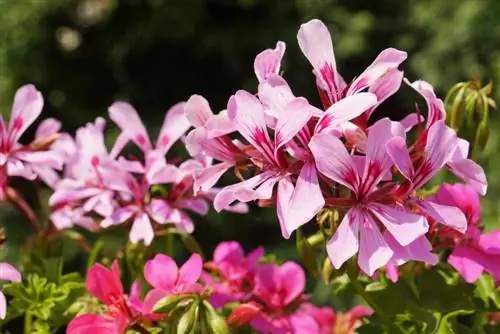
Pelargoniums that overwinter in a bright room can stay in their old pots. During the winter rest they only need basic care.
- Room must not be too warm
- unheated winter garden is ideal
- Stairwell, hallway with window or cool bedroom
- place in a sheltered location, do not expose to direct sun
- water regularly
- Omit fertilizer completely
- cut only in spring shortly before new growth
- then slowly expose to warmer temperatures
- restart fertilizing
- now is also the right time to repot, if necessary
Tip:
Even parts of the plant that have overwintered in light color should definitely be cut back to 20 cm. This stimulates the plant to form new shoots. Flowers are only formed on these new annual shoots.
Dark Winter Quarters
The fragrant pelargoniums spend their time in dark quarters in absolute hibernation. They are neither watered nor fertilized. They are removed from the soil after an autumn cut and prepared for storage.
- Remove all leaves, buds, flowers and new growth.
- Short the remaining empty shoots to 10-20 cm.
- Take the plant out of the flower pot.
- Remove excess soil from the roots. There should only be a little soil left on the roots.
- Put the root ball in a plastic bag without sealing it completely tightly.
- Hang the plants upside down. The room should be cool, with temperatures of 8-10 degrees Celsius.
- Leave the pelargoniums alone. They don't need any funding until February.
- Replant the scented pelargoniums from February. Give it a bright but not too warm place. The time for watering has now begun.
- Start fertilizing in April.
- As soon as the temperatures allow, you can move the pelargoniums outdoors.
Tip:
There can still be a drop in temperature at night up to the Ice Saints. So keep an eye on the weather forecast until mid-May so that you can get your plants back in time if necessary.
Diseases
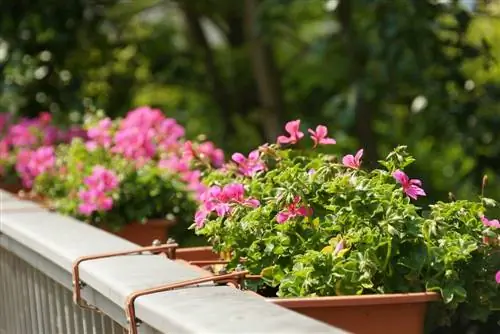
The rust fungus that affects geraniums also likes to spread to pelargoniums. The fungal disease appears with brown circles on the leaf surfaces. Yellow spots can be seen on the undersides. The cause is too much moisture. Either the pelargonium was watered too often and abundantly. Or she is at the mercy of the rain in a rainy summer.
- all damaged leaves and shoots must be removed
- drying the earth is important now
- if applicable The watering intervals and the amount of water must be reduced
- If the old location is not covered, a move must take place
- Geranium rust is contagious
- neighboring plants should also be examined
Note:
Never add infected plant parts to the garden compost. The fungus can survive there and strike again at some point.
Pests
Pelargoniums have little to do with pests. Maybe it's the scent of the leaves that makes them avoid her. This also makes them a sought-after companion to other plants. These benefit from their proximity and also remain pest-free. Only the horse chestnut leaf miner seems to like the scent of pelargoniums. At least this pest is occasionally spotted on them. It eats the stems from the inside. Wasps are natural enemies of this moth's caterpillars. If this pest does become established, action must be taken immediately after the infestation is detected. The entire plant must be radically cut back and the soil completely replaced. It's best if she gets a new pot too.

